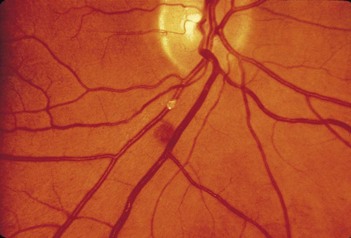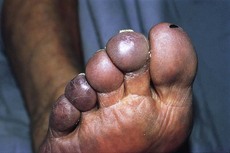209 Cholesterol embolus in the fundus
Salient features
Examination
• Presence of a cholesterol embolus (Hollenhorst plaques) (Fig. 209.1) in one of the branches of the retinal artery.
Questions
What are the complications of such an embolus?
Retinal artery occlusion causing field defects or loss of vision.
What are the causes of retinal arterial occlusion?
• Commonest cause: emboli arising from the major arteries supplying the head or from the left side of the heart; embolic particles consist of platelet clumps, cholesterol crystals or Hollenhorst plaques and others (mixed thrombus, calcific or septic material from cardiac valves, fat, myxoma, talc in intravenous drug abusers or silicone in those who receive injections for cosmetic purposes).
What do you understand by the term amblyopia?
Amblyopia means that impaired vision is not caused by refractive error or ocular disease.
What is the effect of cholesterol crystals?
Cholesterol crystals rarely cause significant obstruction to the retinal arterioles.
How would you manage an acute occlusion of the retinal artery?
• Lie the patient in a supine position to ensure adequate circulation
• Intermittent ocular massage is applied for 15 min to dislodge the emboli, lower intraocular pressure and improve circulation
• Intravenous acetazolamide to lower intraocular pressure
• Inhalation of a mixture of 5% carbon dioxide and 95% oxygen
What do you know about the ‘purple-toe syndrome’?
This was first described with warfarin therapy by Feder and Auerbach in 1961 and was shown to be caused by showers of atheroemboli (Ann Intern Med 1961:55:911–917). Now, with the increasing use of coronary angioplasty and thrombolytic therapy in the elderly, cholesterol emboli are increasingly reported. They result in ‘purple-toes’ (Fig. 209.3), amaurosis fugax and atheroembolic disease of kidneys, skin and GI tract.









